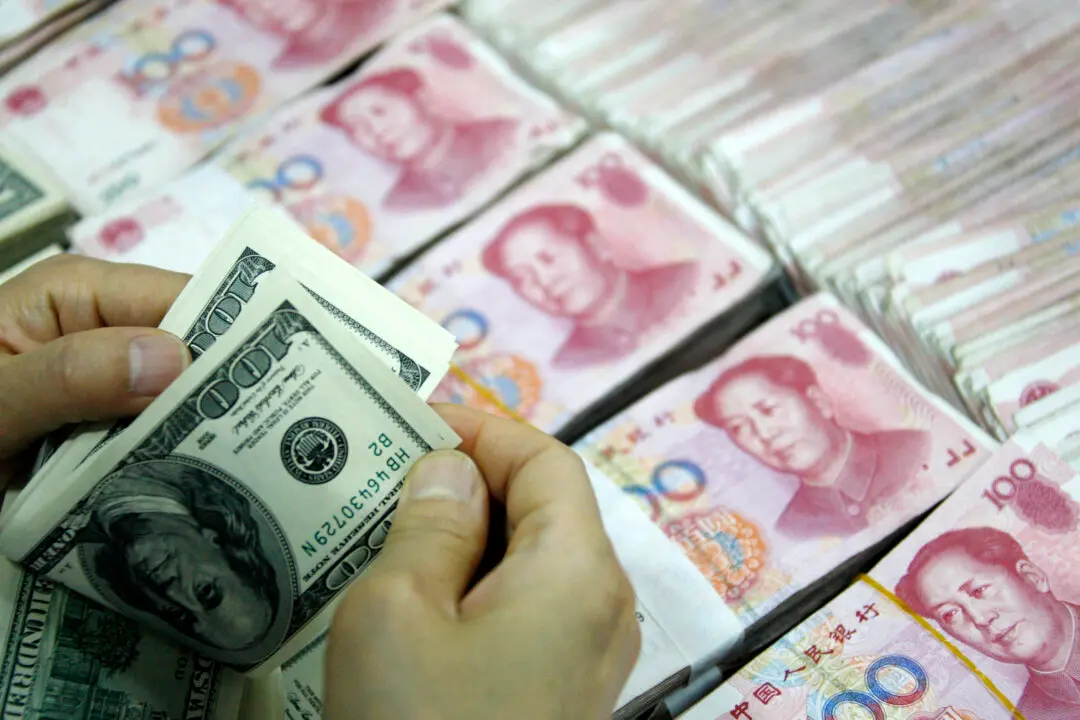Global markets are bracing for a significant devaluation of the Chinese yuan, as its depreciation shows no signs of abating post-Lunar New Year. Investors are actively seeking cost-effective strategies to safeguard against the yuan’s declining value.
In response, Chinese authorities have initiated the sale of U.S. dollars via state-owned banks to mitigate further depreciation. Since 2022, the yuan has faced continuous devaluation, with theoretical projections suggesting the dollar-to-yuan exchange rate surpassing 1:20.
In August 2023, in line with international investors’ expectations, the dollar-to-offshore yuan exchange rate surged to a 16-year high, surpassing the 7.3 threshold. Subsequently, the yuan’s exchange rate has lingered at reduced levels for almost three months. To mitigate this risk, overseas investors have turned to options, considered the most effective tool for hedging against the yuan’s unforeseen depreciation.
Brent Donnelly, president of Spectra FX Solutions and a veteran foreign exchange (FX) trader currently at HSBC New York, noted that the offshore yuan’s short-term implied volatility has been declining since October 2022, indicating a bias toward depreciation. The current one-month and three-month implied volatility rates are at or near two-year lows, making it an opportune time for option buyers to secure affordable protection.
Mr. Donnelly highlights that political dynamics, particularly with respect to China, are influencing market sentiment, as evidenced by the nine-month implied volatility rate not dropping as significantly as shorter-term metrics.
In early February, Mr. Donnelly recommended a one-year call option for the dollar to offshore yuan at 7.60, viewing it as an economical hedging mechanism, with the trading price then at 7.22. This recommendation was made in light of the upcoming U.S. presidential election, suggesting its relevance irrespective of the election outcome.
Jasper Lo, an independent FX analyst, and Kiyong Seong, a macro strategist at Société Générale, a French-based multinational financial services company, have echoed the sentiment for hedging against the yuan’s depreciation.
The People’s Bank of China’s central parity rate has remained relatively static, hovering around 7.10 in recent months. Mr. Seong anticipates that a depreciation beyond 7.25 would compel the Chinese central bank to adjust the central parity rate downward, potentially triggering a negative market response and pushing the dollar/offshore yuan into a range of 7.30 to 7.35.
U.S. Federal Reserve Chairman Jerome Powell’s announcement on Feb. 1 of anticipated rate cuts this year has been tempered by a higher-than-expected U.S. consumer price index for January, dampening hopes for rate reductions in the first half of 2024.
Theoretical Dollar-to-Yuan FX Rate Exceeds 1:20
Wu Chia-Lung, a distinguished macroeconomist from Taiwan, has noted that the yuan has faced depreciation pressures since 2022. He posits that, theoretically, the current dollar-to-yuan exchange rate should exceed 1:20.Mr. Wu’s analysis, rooted in the principle of purchasing power parity (PPP), suggests a significant undervaluation of the yuan against the dollar.
Mr. Wu’s methodology employs PPP, comparing the ratio of the broad money supply (M2) to the gross domestic product (GDP) to gauge the yuan’s value relative to the dollar. With the benchmark exchange rate set at 7.2 (with minor subsequent adjustments), he notes that by the end of December 2023, China’s M2 was 292.27 trillion yuan (about $41 trillion), double that of the U.S. M2 balance of $20.8 trillion.
Meanwhile, China’s GDP for 2023 stood at 126 trillion yuan (approximately $17.5 trillion), which is about 64 percent of the U.S. GDP of $27.36 trillion. Applying these figures, Mr. Wu calculates a theoretical exchange rate of 22.5 yuan per dollar, a stark contrast to the current rate.
During his appearance on NTD’s “Pinnacle View” program, Mr. Wu acknowledged potential inflation within China’s GDP figures, suggesting an even greater possibility for the yuan’s depreciation when considering official data from China. He cautioned, however, that while the PPP-based calculations provide insightful guidance, the actual determination of the yuan-to-dollar exchange rate must also account for China’s economic and political landscape.
Counterview: ‘Government Intervention Determines Yuan’s FX Rate’
Guo Jun, editor-in-chief of the Chinese language edition of The Epoch Times, challenges the straightforward application of PPP for calculating the yuan’s exchange rate, emphasizing the complexities introduced by political and regulatory factors in China.She points out that the ideal conditions presumed by PPP—reflecting pure market economy dynamics—are often disrupted by government interventions, such as price controls or monopolistic practices, which can distort the true supply-demand equilibrium.
During her appearance on “Pinnacle View,” Ms. Guo highlighted the extensive degree of governmental oversight within China, suggesting that the heavier the regulatory hand, the less relevant traditional economic formulas such as PPP become.
She identified China as one of the nations with the most rigorous foreign exchange controls, positing that in scenarios considered critical by the Chinese authorities, it’s conceivable for the country to revert to the stringent foreign exchange regulations reminiscent of the 1980s.
Ms. Guo’s theoretical musings even consider the possibility of an official exchange rate being set arbitrarily, such as 1:1 for the dollar to yuan, under complete government control over currency inflows and outflows.
Recent market activities lend credence to Ms. Guo’s assertions. Since August of the previous year, the dollar-to-onshore yuan exchange rate surged to a yearly peak of 7.36 and remained elevated until November, experiencing a 2.1 percent decline from August to early November.
Notably, on Feb. 20, significant intervention by Chinese state-owned banks aimed at halting the yuan’s depreciation by selling the dollars was reported. These banks were said to convert the yuan to the dollar in the onshore swap market, subsequently selling the dollars in the spot market to bolster the yuan’s value.








